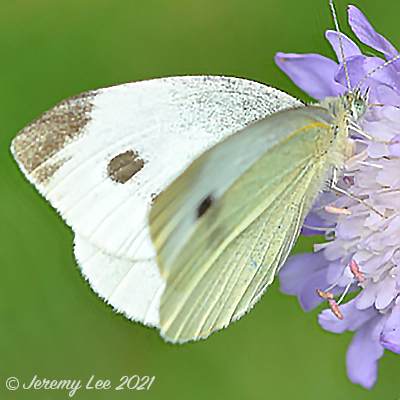
 |
|
Scientific Classifications explained » Amphibians » Ants » Aphids » Bees » Beetles » Birds » Bugs » Butterflies » Caterpillars » Damselflies » Dragonflies » Earwigs » Flies » Frog/Leafhoppers » Fungi » Galls » Grasshoppers » Harvestmen » Hoverflies » Lacewings » Ladybirds » Leaf Mines » Lichens » Mammals » Millipedes » Mosses » Moths » Sawflies » Slugs » Snails » Spiders » Trees & Shrubs » Wasps » Wild Flowers » Woodlice » Postboxes |
UK Nature > Butterflies > Pieris rapae

Scientific Name: Pieris rapae Common Name: Small White Pieris rapae, more commonly known as the Small White, is a small to mid-sized butterfly species of the Yellows-and-Whites family Pieridae. It is also commonly known as the Small Cabbage White. In appearance it looks like a smaller version of the Large White. The upperside is creamy white with black tips to the forewings. Females also have two black spots in the center of the forewings. Its underwings are yellowish with black speckles. It is sometimes mistaken for a moth due to its plain-looking appearance. Its caterpillars can be a pest on cultivated cabbages, but it will readily lay eggs on wild members of the cabbage family such as Charlock (Sinapis arvensis) and Hedge mustard (Sisybrium officinale). The eggs are laid singularly on foodplant leaves. The caterpillars are green and well camouflaged. Like other "White" butterflies it hibernates as a pupa, and like its close relative the Large White this is a strong flyer. The British population is increased by continental immigrants in most years. |
|

https://www.uknature.co.uk is a website dedicated to showing the immense diversity of UK nature and wildlife. Our vast range of habitats, from lowland arable to snow covered mountains, from storm-ravaged coastlines to peaceful inland freshwater lakes and rivers, from dry, sandy heaths to deciduous and coniferous forests, all these habitats contribute to the abundance of UK nature. We have wild birds in huge numbers either residing or visiting our shores (597 recorded species as at July 2013) and we must also not forget the humble back garden with its grass lawns, flower beds filled with nectar rich flowers, shrubs and trees, all designed to attract huge numbers of insects such as bees, moths, butterflies and hoverflies; and finally the small ponds which provide safe havens for frogs, toads, newts and even slow worms and grass snakes. www.uknature.co.uk is the showcase for my personal passion, photographing uknature in all its glory. I sincerely hope you all enjoy the fruits of my labours. This site and all images contained therein is © Jeremy Lee 2004 - 2025. All Rights Reserved. Site design by Jeremy Lee. Site development & IT Support by Stuart Lee. |